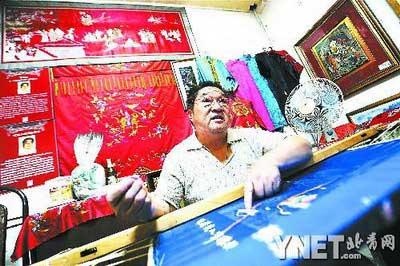 Jul. 22, 2025
Jul. 22, 2025
Weather
Peking Embroidery craftsman worries about future of this heritage
2009-09-03 16:38 BJT
Sometimes, Yao Fuying takes off his reading glasses and looks at the sample patterns in his hand in a daze. He always worries that he may not be able to complete the half-finished dragon robe.
 |
|
Yao Fuying |
For health reasons, he has kept himself away from his studio for 3 months. The small, 20-square meter room is on the first floor of the Baigongfang Museum. Passing a long corridor and pushing the bird cages aside, you can see all kinds of embroideries including cheongsam, Tang-Suits and many other accessories.
They are all the handiwork of this 66-year-old man. As the fourth-generation successor of Master Yao, Yao Fuying is quite familiar with his craft, once popular in royal palaces: what kinds of silk and satin are good, how to match gold and wool threads, how to choose colors and so on. “Black represents mysteries, and yellow, red and blue represent power, happiness and nobleness respectively.” He mutters incessantly in his sickbed.
The 200-year –old craft, along with jewelry enameling, ivory carving and others, are called “the Eight Great Crafts of Beijing.” Yao is quite experienced in splendid past of Peking Embroidery. As a descendant of a technician with the Embroidery Bureau of the Qing Dynasty, Yao did not live together with his parents since childhood and was raised by master embroiderer Bao Shulan. He naturally became very good at embroidery.
He also witnessed the tough time of this craft. In 1950’s, “all old things were looked down upon.” During that period of time, embroideries were purchased at low prices and packed into sacks, and then they were transported here by tractors and dumped in backyards.
Embroiderers have since moved from workshops into factories. Yao also entered into an embroidery factory at the age of 16. At that time, it took him twenty days to embroider patterns on a piece of palm-sized material. For a Tang Suit, he would spend ten months embroidering patterns on it. Furthermore, one piece of embroidery must be done by one person so as to guarantee an even stitching density.
 Mail
Mail Share
Share Print
Print


 Video
Video









 2009 China Central Television. All Rights Reserved
2009 China Central Television. All Rights Reserved